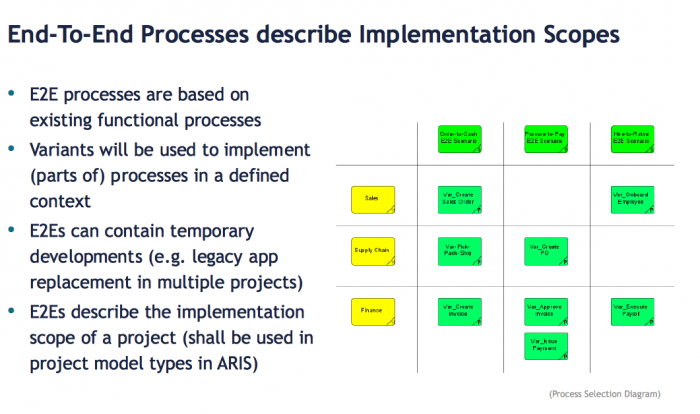We have been modeling only global business processes, and now we would like to incorporate regional processes into our architecture. We are looking for best practices and pitfalls to avoid in the structure of the group/model hierarchies. In addition, please share any strategies to help users easily distinguish between global and regional processes.
8 Replies
-
Marlene,
One way to go is using Process Selection Diagram which should be called Process Selection Matrix by the way but there is a model with such name which is actually a diagram (no idea why they didn't swap names). You probably know that it's used to show processes in different scenarios and is a great tool for navigation, analysis and standardization. Another way of using it is to contain the relations between a local process with its location and with the global one. Unfortunately the object "location" is not allowed in the model but using "main process" could be a way around as it could be linked with location through organisational unit. Not the most elegant solution I must admit.
The Process Support Matrix is a much better tool as you can have locations in the matrix and moreover you simulate different states in time. However, so far its only for the system application type and I don't know of a way to add processes in the process support units (the dynamic cells) instead of applications. But I think that Rick mentioned he used it for a case similar to yours.
Regards
Ivo
-
We also need to incorporate regional processes in our global repository. As our locations are disseminated all over the globe without global intranet connectivity, our intention is to establish a communication channel for processes based on ARIS Express, with Business Process Managers at both ends, and a central BPM uploading models into the platform after validation. When intranet connectivity comes, one day, we'll swap to platform clients.
Rgds,
-
Another alternative might be to use variants if your global processes are the "standard" processes and your regions have local specialties (e.g. due to local legislation or reporting requirements). In this case I would either use a process selection/tree like Ivo suggested or assign the variant models to the same object, so that a pop-up shows when you click the assignment icon in the higher-level model.
-
I would combine both the approaches described by Ivo and Roland. Create variants of the standard process for just those regional processes that are different. Wherever possible try and use the standard process. Then use the Process Selection Diagram to show for each region which process are the standard processes and which are regional variants. The PSD then gives you a nice way of managing the variants and an index to those processes. If you want to be really cleaver you can use model generation to create an end-to-end process for a combination of standard and variant sub-processes.
-
Rob - we are intending to do all of the above. In practical terms, we haven't got very far with it, as we're still trying to tie down standard (aka global) processes.
It's all a bit of a head spin for people. I advise to just create variants of objects, NOT variants of models. Then string together combinations of master and variant functions in an EPC. Do you agree?
I just replied to a TOGAF article, about the practicalities of modelling the evolution from current standard (aka architecture) to target standard. When I posed this to Neil P, that I wanted to use variant objects to define target, I think he agreed. Any thoughts?
A lot hinges on variant management to model dimensions of "global/local" ; "generic/specific" and "current/future"! Scary.
Steve
PS Do many people use aris community? I am having a flurry of activity!! What are the stats?
-
Steve, the statitics question is answered easily - go to the groups page and look for the "I love BPM" group. Every member of this community is added to this group automatically, which means that we have 230,000+ members as of today.
I also do agree that you should create variants of the objects - but on the higher level, and then use occurrence copies of objects in the models. What I typically recommend is that you create variants of the functions in the lowest level VACDs and then assign new EPCs to them (while copying all objects from the "standard" EPC in it and then change/redline the content in the new EPC). I also recommend to use the PSD as Rob describes and one example from a project (somewhat changed of course) is attached ... and yes, it needs some theming/templating :-)
-
In the Process Selection Diagram only row types "consists of" / "Main process" in vertical rows and "Scenario" / "belongs to" in horizontal rows are possible. I would like to show in the horizontal row the standard and if existing the local variant. How to achieve this?
-






